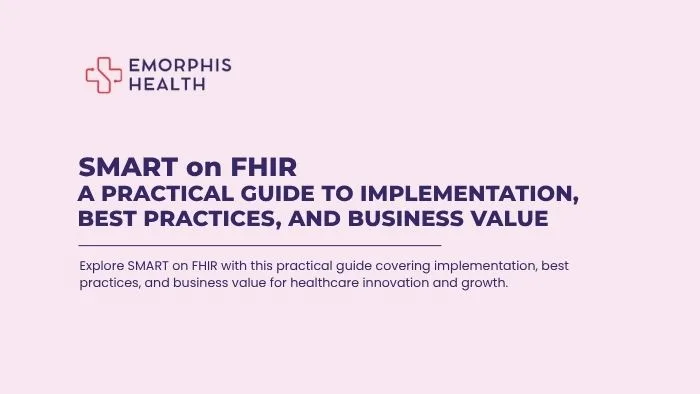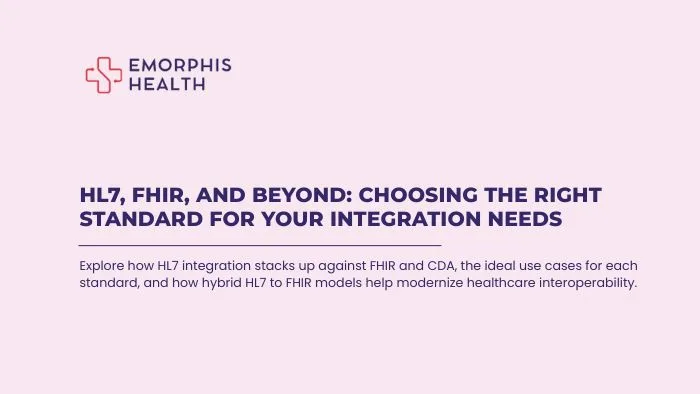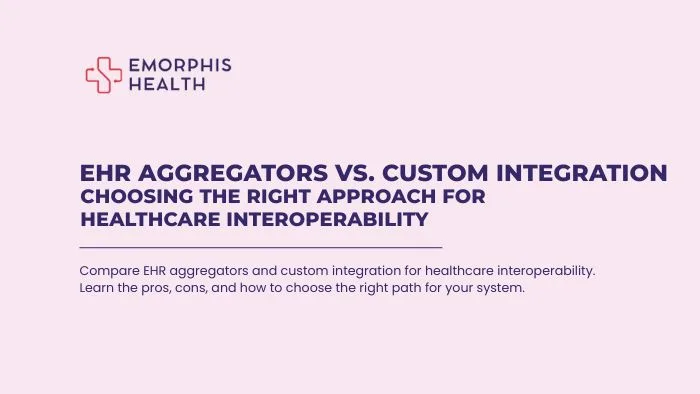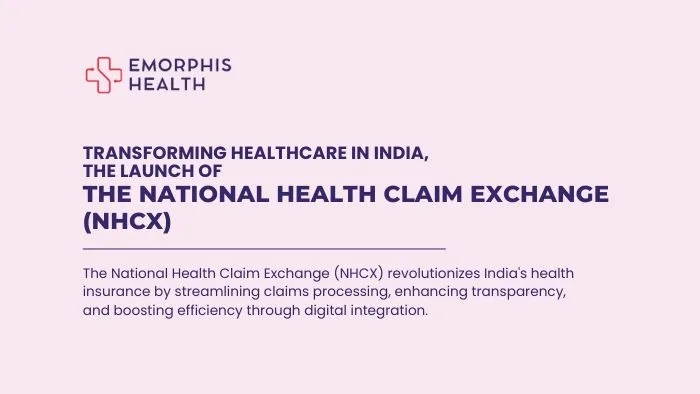Why SMART on FHIR Matters Today
See Contents
- 1 Why SMART on FHIR Matters Today
- 2 Understanding SMART on FHIR Basics
- 3 Advantages of SMART on FHIR for Healthcare Organizations
- 4 Step-by-Step Implementation Roadmap
- 5 Best Practices for Developers and Businesses
- 6 Common Challenges and How to Solve Them
- 7 SMART on FHIR in Action: Business Use Cases
- 8 SMART on FHIR vs Other Integration Options
- 9 Future of SMART on FHIR
- 10 Conclusion
- 11 Frequently Asked Questions about SMART on FHIR
The healthcare industry is moving rapidly toward interoperability. Patients, providers, and payers all want access to the right data at the right time, but the reality is that electronic health records (EHRs) have traditionally been siloed. Even when organizations adopt the FHIR (Fast Healthcare Interoperability Resources) standard, the challenge is not just about accessing data, but about launching apps securely, exchanging data consistently, and scaling adoption across different systems. This is where SMART on FHIR comes in. SMART (Substitutable Medical Applications, Reusable Technologies) provides the authorization and app launch framework that works on top of FHIR APIs. Together, they make it possible for healthcare organizations to plug-and-play third-party apps directly into EHRs, all while maintaining security, compliance, and patient context.
Why it matters now
- Regulatory drivers: The 21st Century Cures Act and ONC interoperability rules require patient access to data and EHR openness.
- Market demand: Healthcare startups and providers are racing to build patient-facing apps, care management platforms, and payer solutions that can work across Epic, Cerner, Athena, and others.
- Strategic advantage: Organizations that adopt SMART on FHIR early can reduce integration costs, accelerate innovation, and stay compliant with evolving regulations.
Most articles explain what SMART on FHIR is, but they stop short of helping organizations apply it strategically. What’s missing are:
- Practical implementation roadmaps for developers
- Business-oriented guides that show ROI and use cases for decision makers
- Best practices and lessons learned from real-world deployments
This guide bridges that gap. Whether you’re a CTO evaluating SMART on FHIR adoption or a developer building a healthcare app, you’ll find both the technical foundation and the strategic perspective needed to move forward.
SMART on FHIR Adoption Is Accelerating
The momentum behind SMART on FHIR is undeniable. According to the U.S. Office of the National Coordinator for Health IT (ONC), nearly 90% of non-federal acute care hospitals now use APIs to enable patient access to their health data through apps, and more than two-thirds have adopted FHIR APIs specifically. Adoption is also rising in patient-facing solutions; hospitals enabling app-based access grew from 68% in 2021 to nearly 80% in 2023-24, while FHIR-based access increased from 56% to almost 70% in the same period. On the developer side, over half of health IT vendors already combine FHIR with OAuth 2.0 to build secure healthcare apps. With 87% of hospitals now served by EHR vendors certified on some version of FHIR, the foundation is in place, making SMART on FHIR one of the most critical enablers of digital health innovation.
Understanding SMART on FHIR Basics
To truly understand the value of SMART on FHIR, it helps to break down its two core components: FHIR and SMART.
- FHIR (Fast Healthcare Interoperability Resources): A standard created by HL7 that defines how healthcare information can be structured and exchanged. FHIR makes it possible for different systems to speak the same “language” by using common data formats and RESTful APIs.
- SMART (Substitutable Medical Applications, Reusable Technologies): A framework that sits on top of FHIR and provides the authorization and app launch mechanism. It ensures that apps connecting to an EHR do so securely and with the right patient or encounter context.
Together, SMART on FHIR allows healthcare apps to integrate with EHRs and other clinical systems in a way that is both secure and interoperable.
How SMART on FHIR Works
- Authentication and Authorization: SMART uses OAuth 2.0 and OpenID Connect to ensure that only trusted apps and users can access data.
- Launch Context: When an app launches, it can receive important context such as patient ID, encounter ID, or user role. This allows the app to present personalized and relevant data immediately.
- Data Access via FHIR APIs: Once authorized, the app can query the EHR using FHIR APIs to retrieve information like lab results, medications, or demographics.
App Types:
- Standalone apps: Apps that patients or providers can open independently to connect with their health data.
- EHR-launched apps: Apps launched directly from inside an EHR workflow, with context passed automatically.
Why It Matters
By combining a standardized data exchange model with a secure app framework, SMART on FHIR makes it possible to build plug-and-play healthcare applications. Instead of creating custom integrations for each EHR, developers can build once and deploy across multiple systems, saving significant time and cost.
Advantages of SMART on FHIR for Healthcare Organizations
Healthcare organizations are under pressure to deliver better patient experiences, meet regulatory requirements, and reduce integration costs. SMART on FHIR offers a solution that addresses these challenges while opening new opportunities for innovation.
Interoperability Across Multiple EHRs
Instead of building one-off integrations with each EHR vendor, SMART on FHIR enables a standardized approach. Apps built once can work across Epic, Cerner, Athenahealth, and other major systems. This reduces technical complexity and allows organizations to adopt new apps more quickly.
Faster Time-to-Market for Healthcare Apps
Developers and digital health startups can launch new applications without navigating months of custom integration work. This shortens the time from idea to deployment and helps organizations respond quickly to changing patient and provider needs.
Compliance with Regulations
SMART on FHIR aligns with mandates from the 21st Century Cures Act and ONC interoperability rules. By adopting SMART on FHIR, healthcare providers can meet requirements for patient data access and information blocking while staying future-ready for upcoming regulatory shifts.
Improved Patient Engagement
With SMART-enabled apps, patients can view their records, track medications, and share data across systems. This transparency not only improves patient satisfaction but also supports better clinical outcomes by giving patients more control over their health journey.
Enhanced Clinical Workflows
Providers benefit from apps that launch within their EHR and display context-specific information. For example, a physician can open a decision support app that automatically loads the current patient’s lab results and medications, reducing manual searches and saving valuable time.
Cost Savings and ROI
By standardizing integration, organizations avoid the expense of maintaining multiple custom interfaces. The result is lower IT overhead and a faster path to ROI on new digital health initiatives.
Find the benefits of Interoperability in healthcare.
Top Benefits of Interoperability in Healthcare and Future Trends
With a clear understanding of SMART on FHIR and the benefits it brings to healthcare organizations, the next step is to explore how to implement it effectively. Knowing the advantages is important, but organizations and developers need a practical roadmap to turn strategy into action.
Step-by-Step Implementation Roadmap
Implementing SMART on FHIR may seem complex at first, but breaking it down into clear steps makes the process manageable. The roadmap below guides both developers and decision-makers through the essential stages of adoption.
Step 1: App Registration and Configuration
- Register your app with the EHR or sandbox environment. This usually involves providing app metadata, redirect URIs, and requested access scopes.
- Define launch type: Decide whether your app will be standalone or launched from within the EHR. Each type has slightly different configuration requirements.
Step 2: Authorization and Scopes
- Use OAuth 2.0 to manage secure access to patient data.
- Define scopes carefully: Scopes specify which resources and operations the app can access. For example,
patient/Observation.readallows the app to read a patient’s lab results. - Implement consent workflows if your app needs explicit patient or provider permission.
Step 3: Accessing Data via FHIR APIs
- Query patient data such as demographics, lab results, medications, and encounters.
- Use standardized FHIR endpoints for consistent behavior across EHRs.
- Handle edge cases like missing resources or partial records gracefully.
Step 4: Testing in Sandbox Environments
- Test your app in controlled environments provided by major EHR vendors (Epic, Cerner, HAPI FHIR).
- Simulate real-world scenarios like multiple patients, different launch contexts, and varying user roles.
- Validate error handling for invalid tokens, missing scopes, and network issues.
Step 5: Deployment and Monitoring
- Deploy to production once testing is complete.
- Monitor usage and performance to ensure the app continues to meet security, compliance, and workflow requirements.
- Update regularly as EHR vendors release new FHIR versions or SMART specifications evolve.
By following this roadmap, healthcare organizations and developers can reduce integration risks, accelerate development timelines, and ensure that apps deliver meaningful value to patients and providers alike.
Understanding the step-by-step implementation of SMART on FHIR is critical, but success goes beyond following a roadmap. Organizations and developers must also adopt best practices to ensure security, performance, and seamless integration, while aligning with business goals. These practices help maximize the value of SMART on FHIR apps and prevent common pitfalls during deployment.
Best Practices for Developers and Businesses
Adopting SMART on FHIR effectively requires more than technical knowledge. Following best practices ensures your app is secure, performs well, and delivers real business value.
Security and Permission Management
- Define scopes carefully: Limit access to only the resources and operations your app truly needs.
- Implement OAuth 2.0 securely: Ensure tokens are encrypted, stored safely, and refreshed correctly.
- Consent handling: Include workflows to capture explicit patient or provider permission when required.
- Audit and logging: Track access to sensitive data for compliance and security monitoring.
Performance Optimization
- Use FHIR paging and bulk export: Avoid overloading the server with large requests.
- Cache data wisely: For frequently accessed information, caching can improve speed without compromising security.
- Asynchronous requests: For heavy data operations, implement async queries to maintain responsiveness.
Business-Oriented Practices
- Align with organizational goals: Ensure your app supports clinical workflows, patient engagement, or operational efficiency.
- Measure ROI: Track adoption, time saved, and improvements in patient outcomes to justify investment.
- Plan for vendor variability: EHR implementations differ. Design your app to handle variations in resource availability or API behavior.
Compliance and Regulation
- HIPAA and GDPR: Ensure data privacy and security in every component of your app.
- ONC Cures Act readiness: Confirm that patient access and interoperability requirements are fully supported.
- Future-proofing: Keep up with evolving FHIR versions and SMART specifications to avoid technical debt.
Testing and Feedback Loops
- End-to-end testing: Simulate real clinical scenarios before deployment.
- User feedback: Collect input from clinicians, patients, and administrators to refine workflows and interfaces.
- Continuous monitoring: Detect errors, latency issues, and unusual access patterns early.
Following these best practices ensures that your SMART on FHIR app is not just technically compliant but also delivers measurable business value, improving adoption, efficiency, and patient satisfaction.
Find the details Healthcare Interoperability Standards guide.
Healthcare Interoperability Standards – A Comprehensive Guide
Common Challenges and How to Solve Them
Even with a clear roadmap and best practices, SMART on FHIR implementation can present challenges. Understanding these issues upfront helps organizations plan better and avoid delays.
Variations Across EHR Vendors
- Challenge: Each EHR may implement FHIR and SMART differently, resulting in inconsistencies.
- Solution: Abstract EHR-specific differences using middleware or adapt your app to handle optional resources and custom extensions. Test across multiple vendor sandboxes before production deployment.
Handling Missing or Incomplete Data
- Challenge: Some patient records may have missing fields or incomplete datasets, causing apps to fail or display inaccurate information.
- Solution: Build apps to handle missing data gracefully, provide default values or alerts, and use robust error-handling routines to ensure reliability.
Debugging Launch Context Issues
- Challenge: Launching apps from within the EHR may fail due to incorrect patient context, encounter ID, or user role.
- Solution: Validate launch parameters during testing, simulate various scenarios, and log errors for rapid troubleshooting.
Performance Bottlenecks
- Challenge: Large datasets, multiple simultaneous users, or slow API responses can affect app performance.
- Solution: Use FHIR paging, bulk export, and asynchronous requests. Implement caching where appropriate and monitor app performance continuously.
Regulatory and Compliance Concerns
- Challenge: Ensuring compliance with HIPAA, GDPR, and ONC Cures Act rules can be complex.
- Solution: Conduct regular audits, enforce secure access protocols, and maintain detailed logs for all data access and transfers.
User Adoption and Workflow Integration
- Challenge: Even technically successful apps may fail if clinicians or patients do not adopt them.
- Solution: Involve end-users early, design intuitive interfaces, and integrate apps seamlessly into existing clinical workflows. Provide training and support to encourage adoption.
By anticipating these challenges and implementing proactive solutions, healthcare organizations can maximize the benefits of SMART on FHIR while minimizing disruptions and delays.
SMART on FHIR in Action: Business Use Cases
SMART on FHIR is more than a technical standard. Its real value comes from enabling apps that solve practical problems for patients, providers, payers, and researchers. Highlighting these use cases demonstrates both the strategic and operational benefits of adoption.
Patient-Facing Apps
- Medication Management: Apps can track prescriptions, send reminders, and alert patients to potential drug interactions.
- Lab Results and Health Records: Patients can access their lab results, imaging reports, and health summaries through a single, secure interface.
- Wellness and Monitoring: Integration with wearables and health devices allows continuous tracking of vitals, activity, and lifestyle metrics.
Provider-Facing Apps
- Clinical Decision Support: Physicians can launch apps that provide real-time alerts, guideline recommendations, and risk scoring based on patient data.
- Dashboards and Analytics: Consolidated views of patient populations help clinicians monitor trends and identify high-risk cases.
- Telehealth Integration: SMART on FHIR enables seamless access to patient history during virtual consultations.
Payer-Facing Apps
- Eligibility and Coverage Checks: Real-time access to patient eligibility reduces delays in prior authorizations.
- Claims Automation: Streamlined data access minimizes manual claims processing and errors.
- Member Engagement: Apps allow payers to provide personalized health tips, reminders, and notifications directly to patients.
Research and Population Health Apps
- Cohort Building: Researchers can create patient cohorts for clinical studies while preserving privacy.
- Population Analytics: FHIR-enabled apps aggregate data across multiple organizations for public health monitoring.
- Clinical Trials: Integration with EHRs accelerates recruitment and data collection for trials.
By showcasing these use cases, organizations can understand how SMART on FHIR translates into tangible value, from improving patient care to reducing operational costs and enabling innovative healthcare solutions.
SMART on FHIR vs Other Integration Options
When evaluating healthcare integration strategies, organizations often compare SMART on FHIR with other approaches such as custom APIs, traditional HL7 interfaces, or FHIR-only implementations. Understanding these differences can help decision-makers choose the right path.
SMART on FHIR vs FHIR-Only Implementations
- FHIR-Only: Provides standardized data access but lacks a defined framework for secure app launches and authorization.
- SMART on FHIR: Adds OAuth 2.0-based security, launch context, and standardized app integration, enabling plug-and-play functionality across EHRs.
SMART on FHIR vs Custom EHR APIs
- Custom APIs: Require building separate integrations for each EHR vendor, increasing development time and costs.
- SMART on FHIR: Offers a consistent, reusable interface across multiple EHRs, reducing technical complexity and speeding deployment.
SMART on FHIR vs Legacy HL7 Interfaces
- HL7 v2: Widely used but often limited to messaging and lacks modern RESTful capabilities.
- SMART on FHIR: Supports modern web standards, real-time access, and better scalability, making it suitable for mobile apps, web dashboards, and AI-enabled solutions.
Key Takeaways
- SMART on FHIR is the most versatile solution for scalable, secure, and interoperable app development.
- It reduces vendor lock-in and ensures apps can be deployed across multiple organizations without custom integrations.
- While other approaches may still have niche uses, SMART on FHIR provides both technical efficiency and strategic business value.
By clearly understanding these differences, healthcare organizations can justify investing in SMART on FHIR and position their apps for faster adoption and measurable ROI.
Future of SMART on FHIR
SMART on FHIR is evolving beyond basic interoperability. Its future lies in supporting advanced healthcare applications, AI-driven insights, and patient-centered digital health ecosystems.
Integration with AI-Powered Healthcare Apps
SMART on FHIR provides standardized access to EHR data, which is essential for AI algorithms that support clinical decision-making, predictive analytics, and personalized treatment plans. Developers can leverage this framework to build AI-enabled apps that improve outcomes while maintaining compliance and security.
Remote Patient Monitoring and Digital Health
With the rise of telehealth and wearable devices, SMART on FHIR allows real-time access to patient-generated health data. This enables continuous monitoring, early intervention, and proactive care, helping providers reduce hospital readmissions and improve chronic disease management.
Expanding Payer-Provider-Patient Collaboration
SMART on FHIR supports seamless data sharing across stakeholders, enabling payers, providers, and patients to collaborate more effectively. From prior authorizations to care coordination and member engagement, organizations can deliver smarter, faster, and more transparent healthcare services.
Preparing for Next-Generation Interoperability
The healthcare ecosystem is moving toward open platforms, cloud-native apps, and cross-organizational data exchange. SMART on FHIR lays the foundation for this future, allowing organizations to scale their digital health initiatives while staying compliant with emerging standards and regulations.
By embracing these trends, organizations not only future-proof their technology investments but also position themselves as leaders in digital health innovation.
Let’s check the details on EHR aggregators vs custom integration.
EHR aggregators vs Custom Integration, Choosing the Right Approach for Healthcare Interoperability
Conclusion
SMART on FHIR is more than a technical framework; it is a strategic enabler for modern healthcare. By combining standardized data exchange with secure app integration, it allows organizations to build scalable, interoperable, and compliant applications that benefit patients, providers, and payers alike.
Throughout this guide, we have explored:
- How SMART on FHIR works and its core components
- The business and clinical advantages it provides
- A practical implementation roadmap for developers
- Best practices, common challenges, and real-world use cases
- Comparisons with alternative integration approaches
- Future trends that will shape digital health
For healthcare organizations and startups, the next step is to move from understanding to action. Partnering with experienced development teams can accelerate your SMART on FHIR adoption, reduce integration risks, and ensure your apps deliver measurable value.
If your organization is looking to develop SMART on FHIR-compliant applications, streamline interoperability, or leverage patient data for innovative digital health solutions, our team can help. From strategy to implementation, we provide end-to-end expertise to turn your vision into reality.
Frequently Asked Questions about SMART on FHIR
1. What is SMART on FHIR and why is it important?
SMART on FHIR is a healthcare interoperability framework that combines FHIR APIs with a secure app launch and authorization system. It allows developers to build applications that can integrate seamlessly with multiple EHR systems. This framework helps organizations improve patient engagement, streamline clinical workflows, and accelerate app deployment while remaining compliant with healthcare regulations.
2. How does SMART on FHIR improve patient engagement?
SMART on FHIR enables apps that give patients access to their health records, lab results, medications, and wellness tracking tools. Patients can view their data, receive reminders, and share information securely with providers. By providing real-time access and interactive features, SMART on FHIR apps empower patients to actively manage their health and improve overall outcomes.
3. What are the benefits of SMART on FHIR for healthcare providers?
Healthcare providers benefit from SMART on FHIR through streamlined workflows, context-aware apps, and faster access to patient data. Clinical decision support apps, dashboards, and telehealth tools can be integrated directly into the EHR. This reduces administrative burden, minimizes errors, improves efficiency, and allows clinicians to focus more on patient care while maintaining regulatory compliance.
4. How is SMART on FHIR different from traditional HL7 or custom APIs?
Unlike legacy HL7 or custom APIs, SMART on FHIR provides a standardized framework for secure, interoperable apps. It combines FHIR for data exchange with OAuth 2.0 for authorization and launch context support. This allows developers to build reusable apps across multiple EHRs without creating separate custom integrations for each system, saving time, cost, and reducing complexity.
5. What are the common challenges in implementing SMART on FHIR?
Challenges include variations in EHR vendor implementations, handling missing or incomplete patient data, performance issues, and ensuring regulatory compliance. Launch context errors and inconsistent API responses are common. To overcome these, developers should implement robust error handling, test across multiple EHR sandboxes, follow best practices for security, and design apps that can handle optional or missing FHIR resources.
6. Can SMART on FHIR be used for AI and advanced healthcare apps?
Yes, SMART on FHIR provides standardized access to EHR data, making it suitable for AI-powered applications, predictive analytics, and personalized treatment planning. By securely retrieving structured patient data, developers can build apps that leverage AI to support clinical decisions, monitor chronic conditions, and improve population health management while ensuring compliance with privacy and security regulations.
7. How does SMART on FHIR support payer and insurance applications?
SMART on FHIR enables payer apps to access real-time eligibility, coverage, and claims data directly from EHR systems. This reduces administrative delays, automates prior authorizations, and improves member engagement. Payers can build apps that provide personalized health guidance, monitor patient adherence, and facilitate collaboration with providers to deliver efficient and cost-effective care management solutions.
8. What is the implementation roadmap for SMART on FHIR?
Implementation involves registering the app with the EHR, defining scopes and authorization protocols, accessing patient data via FHIR APIs, testing in sandbox environments, and deploying in production. Developers should follow best practices for security, error handling, and performance optimization. Continuous monitoring and updates are essential to ensure compliance, interoperability, and alignment with evolving FHIR specifications.
9. How does SMART on FHIR enable interoperability between multiple EHR systems?
SMART on FHIR standardizes data access through FHIR APIs and defines a secure launch context. This enables apps to work across different EHRs without custom integrations for each vendor. By providing reusable, plug-and-play functionality, healthcare organizations can deploy applications efficiently, share data seamlessly, and ensure consistent workflows and user experiences across multiple systems.
10. What is the future of SMART on FHIR in healthcare?
SMART on FHIR is evolving to support advanced healthcare applications, AI-powered analytics, remote patient monitoring, and digital health platforms. It allows cross-stakeholder collaboration between providers, payers, and patients. By adopting SMART on FHIR, organizations can future-proof their digital health strategies, scale innovative apps quickly, and meet regulatory and interoperability requirements effectively.






